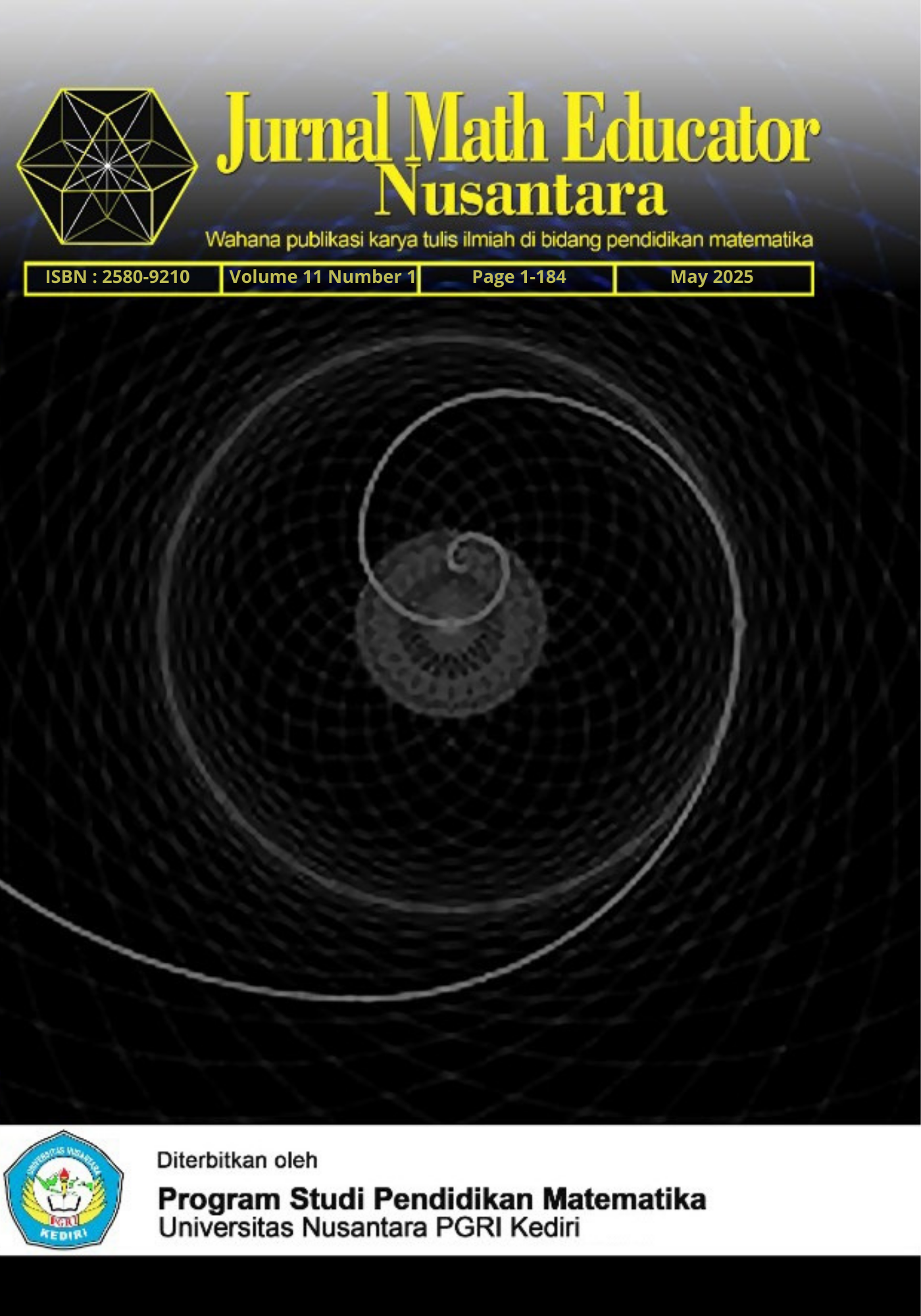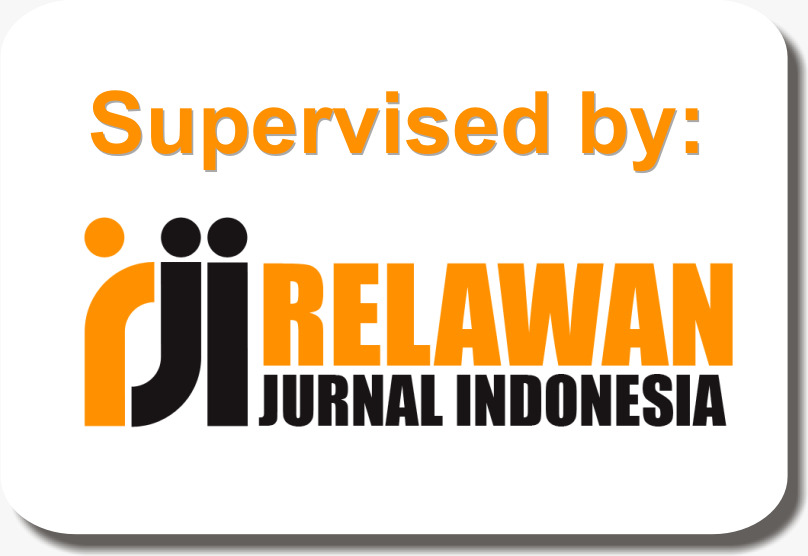The discovery learning model to improve students' mathematical connection ability in exponential material
DOI:
https://doi.org/10.29407/jmen.v11i1.23998Keywords:
Learning, Discovery learning, Mathematical Connection Skills, Exponential MaterialAbstract
Connection ability is one of the mathematical skills standards that students must possess. Mathematical connection ability is the capability to relate mathematics to other fields of study as well as to mathematics itself. In the mathematics instruction for Class X MP 2, based on the results of an initial assessment, it was found that only 20% of students had a sufficiently good connection ability, while the remaining 80% lacked this skill. This study aims to examine the effectiveness of using the discovery learning model to improve the mathematical connection ability of Class X students at SMK Negeri 5 Madiun in exponent material. The study uses a Classroom Action Research (CAR) method, conducted over two cycles. The subjects of the study were 31 students from Class X MP 2 at SMK Negeri 5 Madiun. The study was conducted through several stages in each cycle, namely planning, action, observation, and reflection. The results of this study showed an increase in students' mathematical connection abilities through the application of the discovery learning model. Learning using the discovery learning model in mathematics for Class X MP 2 at SMK Negeri 5 Madiun can enhance students' mathematical connection abilities from 46.67% in the pre-cycle, 68.33% in Cycle I, to 78.3% in Cycle II.
References
Aisyah, A. S., & Madio, S. S. (2021). Peningkatan Kemampuan Representasi Matematis Siswa dengan Pembelajaran Berbasis Masalah Melalui Pendekatan Konstekstual dan Matematika Realistik. Plusminus: Jurnal Pendidikan Matematika 1(2), 363-372.
Amalia, R., Lutfiyah, P., & Afrillia, V. (2019). Deskripsi Kemampuan Koneksi Matematis Siswa Berkemampuan Tinggi Dalam Menyelesaikan Soal Cerita. Jurnal Ilmiah Pendidikan Matematika, 44-52.
Angelina, M., & Effendi, K. N. (2021). Analisis Kemampuan Koneksi Matematis Siswa SMP Kelas IX. Jurnal Pembelajaran Matematika Inovatif, 4(2), 383-394.
Budiastuti, P. N., Rosdiana, R., & Ekowati, A. (2023). Analisis Langkah-Langkah Model Pembelajaran Discovery Learning dalam Rencana Pelaksanaan Pembelajaran Teks Cerita Inspiratif Kelas IX SMP Di Kabupaten Bogor Utara. Triangulasi: Jurnal Pendidikan Kebahasaan, Kesastraan, dan Pembelajaran 3(1), 39-45.
Cahyani, I. D., Fathani, A. H., & Faradiba, S. S. (2023). Penerapan Braind Based Learning Dalam Meningkatkan Kemampuan Koneksi Matematis Siswa Kelas VIII-A SMPN 1 DAU. Jurnal Penelitian, Pendidikan, dan Pembelajaran, 18(2), 1-7.
Darmawansyah, S. P., Azmi, S., Wahidaturrahmi, & Hayati, L. (2022). Analisis kemampuan koneksi matematis siswa dalam menyelesaikan soal cerita matematika. Griya Journal of Mathematics Education and Application, 2(1), 205-213. https://doi.org/10.29303/griya.v2i1.145
Fani, A. A., & Effendi, K. N. (2021). Kemampuan Koneksi Matematis Siswa Ditinjau Dari Kecemasan Belajar Pada Siswa SMP Pada Materi Lingkaran. JPMI (Jurnal Pembelajaran Matematika Inovatif), 4(1), 137-148.
Fatharani, C., Irvan, & Aziz, Z. (2024). Pengaruh Model Pembelajaran Problem Based Learning dan Discovery Learning Terhadap Kemampuan Koneksi Matematis Siswa. JMES (Journal Mathematics Education Sigma, 5(1), 36-46.
Hayati, N., Wahyuni, R., & Nurhayati. (2018). Analisis Kemampuan Koneksi Matematis Siswa dalam Memecahkan Masalah Geometri Berdasarkan Tingkat Berpikir Van Hiele di Kelas VIII Mts Al-Falah Singkawang. Jurnal of Education Review and Research.
Hernawati, P. L., Prijambodo, C. K., & Wicaksono, A. (2024). Ethnomathematics studies according to the bishop in Chinese culture at the Sanggar Agung Chinese temple as basic literacy in mathematics. AIP Conference Proceedings, 3201(ue 1)). https://doi.org/10.1063/5.0230758
Hutasoit, A. H. (2022). Model Discovery Learning untuk Meningkatkan Kemampuan Penalaran Matematis Peserta Didik di SMA Negeri 1 Sipoholon. SEPREN: Journal of Mathematics Education and Applied, 4(1), 81–87. https://doi.org/10.36655/sepren.v4i01.846
Imamuddin, I., Putra, A., & Rahmadila. (2019). Kemampuan Koneksi Matematika Siswa Dengan Pendekatan Kontekstual Di SMPN 1 Banuhampu. 7(1), 11-22. https://doi.org/10.24256/jpmipa.v7i1.560
Istiqomah, Q., & Nurulhaq. (2021). Perbandingan Kemampuan Koneksi Matematis Siswa antara Model Pembelajaran Discovery Learning dan Ekspositori. Plusminus: Jurnal Pendidikan Matematika, 1(1), 135–144. https://doi.org/10.31980/plusminus.v1i1.884
Lestari, A. Y., Imswatama, A., & Mulyanti, Y. (2024). Penerapan Model Pembelajaran Missouri Mathematics Project ( MMP) terhadap Kemampuan Koneksi Matemais Siswa Sekolah Menengah Pertama. Jurnal Basicedu, 1(1), 196–205. https://doi.org/10.20527/edumat.v3i1.629
Lusiana, R., & Setyansah, R. K. (2023). Pengaruh Motivasi Belajar Terhadap Prestasi Akademik Materi Aljabar Linier Menggunakan MATLAB Mobile. SIGMA, 8(2), 108-116.
Marsiani, E., Lusiana, R., & Sulistryorini. (2023, Agustus). Peningkatan Pemahaman Konsep Matematis Siswa Sekolah Dasar Dengan Menggunakan Model Pembelajaran Discovery Learning Berbantuan Diagram Gambar. Konferensi Ilmiah Dasar, UNIVERSITAS PGRI MADIUN.
Masruroh, V., Lusiana, R., & Susanti, V. D. (2022, Agustus). Analisis keterampilan abad 21 siswa dalam menyelesaikan soal turunan fungsi aljabar ditinjau dari gender. SEMINAR NASIONAL SOSIAL, SAINS, PENDIDIKAN, HUMANIORA (SENASSDRA), UNIVERSITAS PGRI MADIUN.
Muharomi, L. T., & Afriansyah, E. A. (2022). Kemampuan Koneksi Matematis dan Kemandirian Belajar Siswa Pada Materi Sistem Persamaan Linear Dua Variabel. Leibniz: Jurnal Matematika.
NCTM. (2000). Principles and standards for school mathematics. Author.
Nurhamida, B. (2021). Implementasi Pembelajaran Kalor Melalui Pendekatan Saintifik Dengan Model Pembelajaran Discovery Learning Mata Pelajaran IPA Siswa MTs. STRATEGY:Jurnal Inovasi Strategi dan Model Pembelajaran, 2(1), 101-107. https://doi.org/10.51878/strategi.v2i1.946
Nurulhaq, C., & Istiqomah, Q. (2021). Perbandingan Kemampuan Koneksi Matematis Siswa antara Model Pembelajaran Discovery Learning dan Ekspositori Plusminus : Jurnal Pendidikan Matematika.
Permatasari, R., & Nuraeni, R. (2021). Kesulitan Belajar Siswa SMP mengenai Kemampuan Koneksi Matematis pada Materi Statistika. Plusminus: Jurnal Pendidikan Matematika, 1(1), 145-156. https://doi.org/10.31980/plusminus.v1i1.885
Prasetyo, F., & Kristin, F. (2020). Pengaruh Model Pembelajaran Problem Based Learning dan Model Pembelajaran Discovery Learning terhadap Kemampuan Berpikir Kritis Siswa Kelas 5 SD. Didaktika Tauhidi: Jurnal Pendidikan Guru Sekolah Dasar, 7(1), 13-27.
Putri, H. E., & Adipura, Y. (2022). Analisis Kemampuan Koneksi Matematis Siswa SMA Pada Materi Trigonometri. GAUSS: Jurnal Pendidikan Matematika, , 5(2), 29-39.
Rosyana, S. I., & Effendi, K. N. S. (2021). Kemampuan Koneksi Matematis Siswa SMP Pada Materi Bangun Datar. MAJU.
Safitri, A. O., Handayani, P. A., Yunianti, V. D., & Prihantini. (2022). Pengaruh Model Pembelajaran Discovery Learning terhadap Peningkatan Hasil Belajar Siswa SD. Jurnal Penelitian Tambusai, 6(2), 9106-9114.
Sahensolar, J. A., & Susilowaty, N. (2020). Meningkatkan Kemampuan Koneksi Matemais Siswa SMP Melalui Model Pembelajaran Accelerated Learning Cycle (ALC) dan Probing Prompting. Jurnal Padegogik, 3(2), 118–127. https://doi.org/10.35974/jpd.v3i2.2368
Sari, I. J., & Sari, A. (2019). Pengaruh Penerapan Model Pembelajaran Think Pair Share terhadap Kemampuan Representasi Matematis ditinjau dari KemampuanAwal Matematika Siswa. Juring(Journal for Research in Mathematics Learning, 2(3), 191–198. https://doi.org/10.24014/juring.v2i3.7525
Sugiyanto, & Wicaksono, A. B. (2020). Penerapan Model Discovery Learning Untuk Meningkatkan Pemahaman Konsep Matematika Siswa SMA Pada Kompetensi Pertidaksamaan Rasional dan Irasional. Indonesian Journal of Education and Learning
Susilo, H., Chotimah, H., & Sari, Y. D. (2011). Penelitian Tindakan Kelas Sebagai Sarana Pengembangan Keprofesionalan Guru dan Calon Guru. Bayumedia Publishing.
Widari, R. P., Muhtarom, H., L, & Istianah, N. (2023). PenerapanDiscovery Learning Berbantuan GeoGebra untuk Meningkatkan Kemampuan Representasi Matematis Siswa SMK. Integral: Jurnal Penelitian Pendidikan Matematika, 5(2), 110–121.
Ziliwu, S. H., Sarumaha, R., & Harefa, D. (2022). Analisis Kemampuan Koneksi Matematika Pada Materi Transformasi Siswa Kelas XI SMK Negeri 1 Lahusa Tahun Pembelajaran 2020/2021. AFORA: Jurnal Pendidikan Matematika, 1(1), 15-25. https://doi.org/10.57094/afore.v1i1.433
Downloads
Published
Issue
Section
License
Copyright (c) 2025 Binti Khoiriyah, Restu Lusiana, Sri Wahyu Utami

This work is licensed under a Creative Commons Attribution 4.0 International License.
Authors who publish with this journal agree to the following terms:
- Copyright on any article is retained by the author(s).
- The author grants the journal, the right of first publication with the work simultaneously licensed under a Creative Commons Attribution License that allows others to share the work with an acknowledgment of the work’s authorship and initial publication in this journal.
- Authors are able to enter into separate, additional contractual arrangements for the non-exclusive distribution of the journal’s published version of the work (e.g., post it to an institutional repository or publish it in a book), with an acknowledgment of its initial publication in this journal.
- Authors are permitted and encouraged to post their work online (e.g., in institutional repositories or on their website) prior to and during the submission process, as it can lead to productive exchanges, as well as earlier and greater citation of published work.
- The article and any associated published material is distributed under the Creative Commons Attribution-ShareAlike 4.0 International License
















